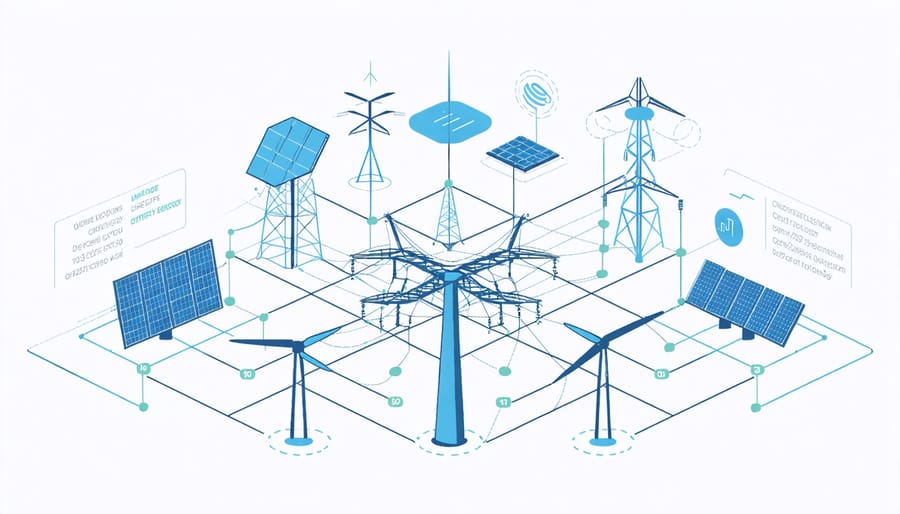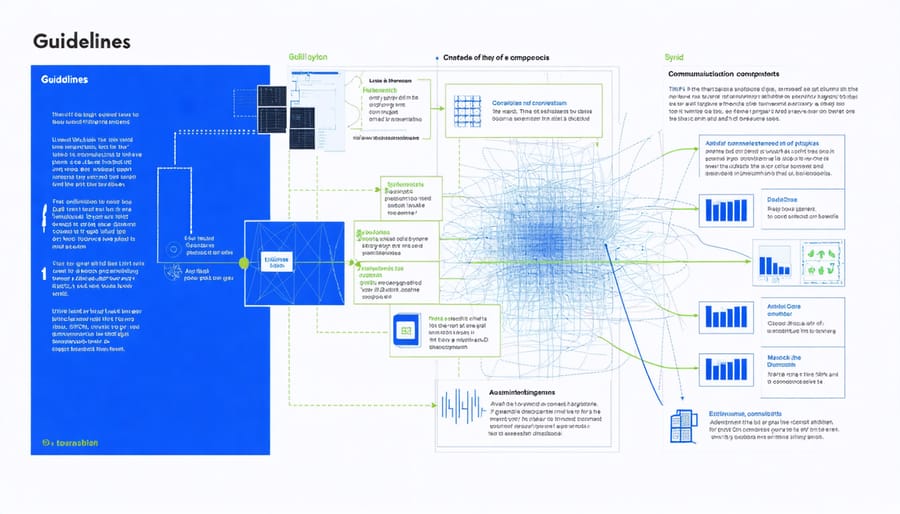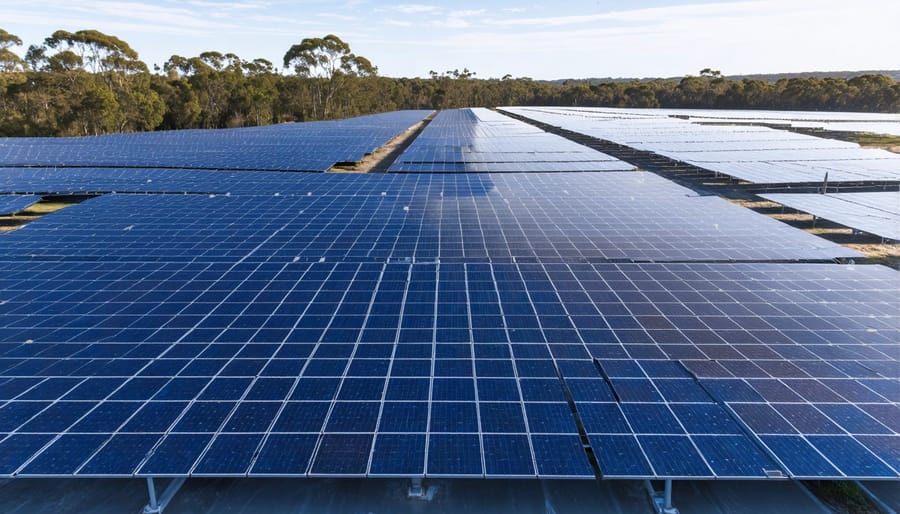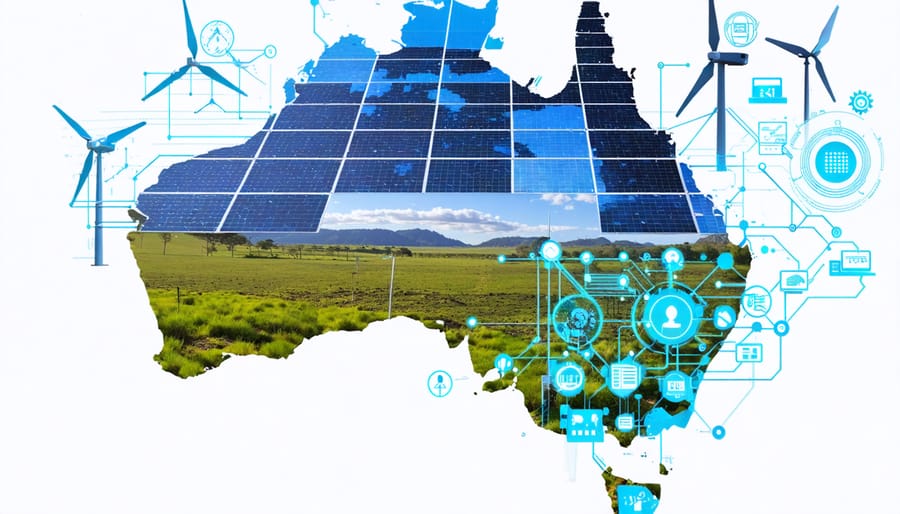In today’s interconnected energy landscape, interoperability standards serve as the invisible backbone powering our transition to renewable energy. As Australia’s power grid evolves to accommodate diverse energy sources, smart grid technology and seamless communication protocols have become critical for success. These standards enable everything from rooftop solar systems to utility-scale wind farms to work in harmony, speaking the same digital language across platforms, manufacturers, and geographic boundaries.
Like a well-orchestrated symphony, interoperability standards ensure that every component of our energy infrastructure performs its role perfectly, creating a resilient and efficient network that adapts to changing demands. For Australian communities embracing renewable energy, these standards translate into tangible benefits: reduced costs, improved reliability, and accelerated clean energy adoption.
Yet the true power of interoperability lies not just in technical specifications, but in its ability to democratize energy distribution, enabling consumers and producers alike to participate in our energy future. As we stand at the threshold of a new energy era, these standards are shaping how we generate, distribute, and consume power in ways that were unimaginable just a decade ago.
Why Grid Interoperability Standards Matter for Renewable Energy

The Integration Challenge
Connecting diverse renewable energy sources to Australia’s power grid presents unique technical challenges that require innovative solutions. As solar farms, wind turbines, and other renewable installations multiply across the continent, grid operators face the complex task of harmonizing these varied power sources. Each type of renewable energy generates power differently, with varying voltage levels, frequency patterns, and output consistency.
The integration challenge is further complicated by the need to balance these fluctuating power sources with energy storage systems and traditional power plants. Weather-dependent renewables can cause rapid changes in power supply, requiring sophisticated control systems to maintain grid stability. This becomes particularly crucial in remote areas where grid infrastructure may be less robust.
Additionally, legacy equipment and outdated communication protocols can create bottlenecks in data exchange between different grid components. Grid operators must navigate these technical hurdles while ensuring reliable power delivery and maintaining system security. Despite these challenges, successful integration projects across Australia demonstrate that with proper planning and standardization, these obstacles can be overcome effectively.
Benefits of Standardization
Implementing uniform standards across renewable energy systems delivers remarkable benefits that ripple throughout the entire energy sector. When all components speak the same language, we see dramatic improvements in system reliability and significant cost reductions in both installation and maintenance.
For Australian energy providers and consumers alike, standardization creates a more competitive marketplace. Equipment from different manufacturers can work together seamlessly, giving operators more choices and better pricing options. This “mix and match” capability also makes it easier to upgrade systems gradually rather than requiring complete overhauls.
Safety and quality assurance improve substantially with standardization. When everyone follows the same protocols, technicians can work more efficiently, reducing the risk of errors during installation and maintenance. This is particularly crucial in remote Australian communities where technical support might be limited.
Perhaps most importantly, standardization accelerates innovation. With clear guidelines in place, manufacturers can focus on improving their products rather than ensuring basic compatibility. This has already led to faster adoption of new technologies in solar and wind power systems across the country, helping Australia move more quickly toward its renewable energy goals.
Key Interoperability Standards for Australian Renewable Grids
Communication Protocols
In today’s interconnected energy landscape, communication protocols serve as the vital digital language that enables seamless data exchange between various grid components. Australia’s renewable energy sector has embraced several key protocols that ensure different devices and systems can work together effectively.
The most widely adopted protocol is Modbus, which acts as a common language for solar inverters, battery systems, and monitoring equipment. This straightforward protocol has proven particularly valuable in rural installations, where simplicity and reliability are essential. Following closely is DNP3 (Distributed Network Protocol), which has become the go-to standard for utility-scale renewable projects across the country.
For more sophisticated operations, IEC 61850 has emerged as the gold standard, enabling high-speed communication between smart grid components. This protocol has been successfully implemented in several major solar farms in Queensland and South Australia, demonstrating its effectiveness in managing complex renewable energy systems.
The latest addition to this communication family is MQTT (Message Queuing Telemetry Transport), which is gaining traction in IoT-enabled renewable installations. Its lightweight nature makes it perfect for remote monitoring and control of distributed energy resources, a feature particularly valuable in Australia’s vast geographical expanse.
These protocols work together to create a robust communication framework, ensuring that our renewable energy infrastructure operates efficiently and reliably, while remaining flexible enough to accommodate future innovations.

Grid Connection Standards
Connecting renewable energy sources to the power grid requires adherence to strict technical standards that ensure safety, reliability, and system stability. In Australia, these standards are primarily governed by AS/NZS 4777 for small-scale installations and the National Electricity Rules for larger systems.
For solar installations, inverters must meet specific power quality requirements, including voltage and frequency tolerances. These devices need to automatically disconnect from the grid during power outages and reconnect only when safe conditions are restored. Modern smart inverters also need to support volt-watt and volt-var response modes, helping maintain grid stability during varying weather conditions.
Wind farms face additional requirements, such as fault ride-through capability and reactive power support. These facilities must demonstrate their ability to maintain connection during brief network disturbances and help regulate system voltage.
Battery storage systems require bi-directional metering and sophisticated control systems to manage both charging and discharging operations. The standards specify maximum ramp rates for power output changes and minimum response times for frequency control services.
Success stories like the Hornsdale Power Reserve in South Australia demonstrate how well-implemented grid connection standards enable seamless integration of renewable sources. The facility provides essential grid services while maintaining strict compliance with technical requirements, proving that renewable energy can reliably support our power system when proper standards are followed.
Looking ahead, these standards continue to evolve as new technologies emerge, ensuring our grid remains ready for an increasingly renewable future.
Safety and Security Standards
In today’s interconnected energy landscape, robust safety and security protocols form the backbone of reliable grid operations. These standards ensure that renewable energy systems can seamlessly integrate while maintaining the highest levels of protection against both physical and digital threats.
The Australian Energy Market Operator (AEMO) has established comprehensive security frameworks that align with international best practices. These protocols include real-time monitoring systems, automated fault detection, and rapid response mechanisms that protect grid infrastructure from potential disruptions.
Grid cybersecurity has become increasingly crucial as our energy systems become more digitised. The standards mandate encryption protocols, secure authentication methods, and regular security audits to safeguard against cyber threats.
Physical security measures are equally important, with requirements for robust perimeter protection, access control systems, and emergency response procedures. These standards ensure that critical infrastructure remains protected while maintaining operational efficiency.
Australian energy providers must also comply with the Security of Critical Infrastructure Act, which sets clear guidelines for risk management and incident reporting. This framework helps create a resilient energy network that can withstand various challenges while supporting the growth of renewable energy integration.
The implementation of these standards has already shown positive results, with significant reductions in security incidents and improved system reliability across the national grid.
Implementing Standards in Practice

Success Stories
The Western Australian Solar Smoothing Project stands as a shining example of successful interoperability implementation. In 2020, Western Power integrated multiple solar farms across the Perth metropolitan area using standardized communication protocols, resulting in a 40% improvement in grid stability and reduced maintenance costs.
Another remarkable success story comes from the Melbourne Smart Grid Initiative, where different vendors’ equipment seamlessly communicates thanks to adherence to IEC 61850 standards. This project has enabled real-time monitoring of renewable energy sources across 50,000 households, leading to a 25% reduction in response time during power fluctuations.
The Regional Queensland Virtual Power Plant demonstrates how interoperability standards can unite diverse energy resources. By implementing standardized protocols, the project successfully connected 5,000 residential solar systems with 500 battery storage units from different manufacturers. This integration has helped balance the grid during peak demand periods and reduced reliance on fossil fuel generators by 30%.
Tasmania’s Distributed Energy Resource Management System showcases the power of standardization in remote areas. The project connects wind farms, hydroelectric plants, and residential solar installations across the state, maintaining stable power supply even in challenging weather conditions. Since its implementation in 2021, the system has prevented 12 major outages and saved an estimated $4.5 million in infrastructure costs.
Implementation Guidelines
Implementing interoperability standards requires a structured approach that begins with a thorough assessment of existing systems. Start by forming a dedicated team that includes technical experts, stakeholders, and end-users to oversee the implementation process. This team should develop a clear roadmap that outlines specific milestones and timelines.
The first practical step is conducting a gap analysis between current systems and desired interoperability standards. Document all existing protocols, interfaces, and data formats currently in use. This assessment helps identify areas requiring immediate attention and allows for prioritisation of necessary upgrades.
Next, develop a detailed implementation plan that includes testing protocols and verification procedures. It’s crucial to establish a pilot program before full-scale deployment. Many Australian renewable energy projects have successfully used this approach, starting with small-scale trials before expanding to larger implementations.
Training and documentation are essential components of successful implementation. Ensure all staff members receive appropriate training on new protocols and procedures. Create comprehensive documentation that includes technical specifications, user guides, and troubleshooting procedures.
Regular monitoring and evaluation help maintain compliance with standards. Implement a feedback system to capture user experiences and technical issues. This information proves invaluable for continuous improvement and future updates to the system.
Remember to maintain open communication channels with vendors and partners throughout the implementation process. Their expertise and support can significantly smooth the transition to new standards and help avoid common pitfalls.
The Future of Grid Interoperability
The future of grid interoperability in Australia looks incredibly promising, with emerging standards set to revolutionize how we manage and integrate renewable energy sources. As technology evolves, we’re seeing a shift towards more sophisticated and unified approaches to grid management, particularly through AI-powered grid management systems.
One of the most exciting developments is the emergence of OpenADR 3.0, which promises to create seamless communication between different energy resources and grid operators. This next-generation standard will enable real-time response to energy demands while maintaining grid stability across diverse renewable sources.
The IEEE 2030.5 standard is also evolving to accommodate emerging technologies like vehicle-to-grid integration and community battery storage systems. This evolution will be crucial for supporting Australia’s growing electric vehicle market and neighborhood-level energy sharing initiatives.
Industry experts predict that by 2025, we’ll see the widespread adoption of blockchain-based interoperability standards, enabling secure and transparent energy trading between consumers and producers. This advancement will particularly benefit remote communities, allowing them to establish self-sufficient microgrids while maintaining connectivity with the broader network.
The introduction of Universal Grid Protocol (UGP) is another game-changer on the horizon. This protocol aims to create a common language for all grid-connected devices, regardless of manufacturer or technology type. For Australian energy providers and consumers, this means simpler integration of new technologies and reduced implementation costs.
Looking further ahead, the development of quantum-resistant security protocols will ensure our grid infrastructure remains protected as computing technology advances. These protocols will be essential for maintaining the integrity of our increasingly interconnected energy systems while supporting the transition to a fully renewable future.
The success of these emerging standards will depend on continued collaboration between industry stakeholders, government bodies, and communities. By working together, we can create a more resilient, efficient, and sustainable energy network for all Australians.
The adoption of interoperability standards represents more than just technical compliance – it’s a crucial stepping stone towards a sustainable and resilient energy future for Australia. As we’ve seen through successful implementations across the country, from solar farms in Queensland to wind projects in Victoria, standardisation creates opportunities for innovation while ensuring system reliability and security.
The time to act is now. Industry stakeholders, from equipment manufacturers to energy providers, must embrace these standards not as barriers but as enablers of growth and efficiency. For businesses, this means investing in compliant technologies and updating existing systems. For policymakers, it requires creating supportive frameworks that encourage standard adoption while maintaining flexibility for future innovations.
The path forward is clear: collaboration between industry players, government bodies, and standards organizations will be essential. By working together, we can create an energy ecosystem that’s not only interconnected but also robust enough to support Australia’s renewable energy targets.
Let’s make interoperability standards the foundation of our clean energy future. Whether you’re a system operator, technology provider, or policy maker, your role in adopting and promoting these standards is vital. The success stories we’ve explored show that when we commit to standardisation, we create lasting positive change for our communities and environment.
Together, we can build an energy network that’s as reliable as it is sustainable, proving that Australia can lead the way in renewable energy integration through smart, standardised solutions.

